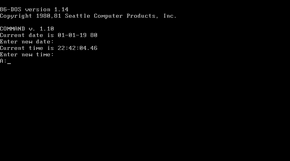Build list legend
Non-existent page
 | |
| Developer | Seattle Computer Products / Tim Paterson |
|---|---|
| Source model | Closed source |
| Initial release | 86-DOS 0.11 (August 1980) |
| Latest release | 86-DOS 1.14 (December 1981) |
| Supported platforms | x86 |
| Kernel type | Monolithic |
| User interface | Command-line interface |
| License | Proprietary |
86-DOS, known internally as QDOS and occasionally in official documents as Seattle DOS and SCP-DOS,[1] is an operating system developed by Seattle Computer Products that was later licensed[2] and then bought[3] by Microsoft and used as the basis for IBM PC-DOS and MS-DOS.
Seattle Computer Products created and put up for sale one of the first 8086 computer kits, but its sales were minimal due to the lack of software written for it.[4] CP/M-86, expected to be the first venture into the 8086 software world, had been delayed since December 1979,[5][6] and by February 1980 they felt pressure to supply something for their devices.
Employee Tim Paterson, who had done hardware work at Seattle Computer Products prior to 1980 and only some software work in college,[7] got the idea of creating his own operating system during the time he was working on the company's 8086 board.[6] On or around February 6, 1980, Paterson had a board meeting with Rod Brock, owner of Seattle Computer Products, who gave him the go-ahead on his idea.[8] One of the primary goals of the operating system was translation compatibility with CP/M,[9][10] so most internal functions were reimplemented based on the CP/M-80 manual.[11] Another goal was a more efficient file system, reimplemented from his memory of an unfinished 8-bit operating system known as Microsoft Interrupt Driven Asynchronous System (MIDAS,[9] or MDOS[12] before 1980[a]), written by Marc McDonald,[9][12] which he learned about during the 1979 National Computer Conference.[7][b] Further inspiration was taken from North Star and Cromemco's variants of CP/M-80,[5] UCSD p-System, Unix,[7] CDC SCOPE, Cromemco RDOS, and the IMSAI 8080 Self-Contained System.[8]
Development officially began in April 1980,[4][c] with code written in MicroPro WordMaster[7][15] on on a Cromemco Z80 computer[15][16] running CDOS.[7] While some code was written in pure 8086 assembly, most was written in the more familiar Z80 assembly and then translated using Paterson's Z80 to 8086 translator, TRANS-86,[7][17] for testing on the Seattle Computer Products 8086 system.[18] The operating system was in a workable state by late July, with Paterson spending about half of his time on its development.[4][19] Though it wasn't completely finished, Paterson figured a quick release was more important than adding all the features.[20]
The very first 86-DOS advisement was submitted in July 1980 and appeared in the August 1980 issue of the BYTE Magazine[21] and the August 25 issue of Computer Business News[22]. It costed $95 for SCP hardware owners and $195 for other buyers at launch.[21] The advertisement was likely for 86-DOS 0.11, however due to press deadlines, it was submitted before 86-DOS 0.11 was ready, and hence the features described in the advertisement were Rod Brock's prediction.
On the morning on September 22, 1980, about a month after 86-DOS 0.11 was released, Paul Allen of Microsoft called Rod Brock of Seattle Computer Products and told him they had an anonymous customer (IBM) interested in sublicensing 86-DOS.[23] The next day, they reached a verbal agreement, and on the 24th the terms of the nonexclusive sublicense were set in stone.[23] The license agreement was finally signed on January 6, 1981.
Microsoft purchased 86-DOS in summer 1981 and renamed it to MS-DOS, shortly before the initial release of PC-DOS.
86-DOS is known to have been sold by Lomas Data Products with their LDP88, an 8088 processor, and LDP72, their floppy disk controller. 2 ads were posted for this OEM, with one being from October 1980[24] and another being from December 1980.[25][d] In both ads, the OEM was priced $195, having no markup on the original retail price.[24][25][26]
Build list legend